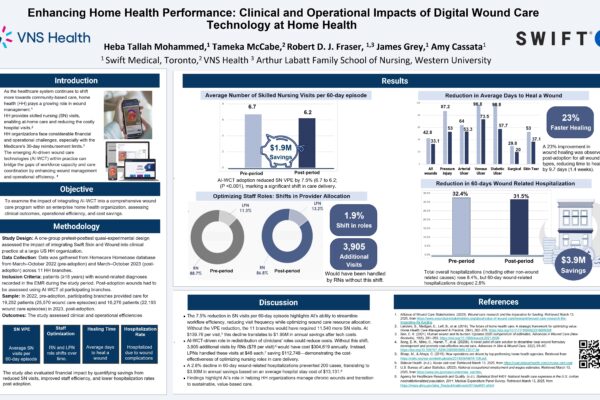Welcome to Swift Medical’s multi-part series on the new Home Health Value-Based Purchasing Model.
Feeling unsure about what impact the upcoming Home Health Value Based Purchasing Model (HHVBP) will have on your organization? You’re not alone. A recent survey by Home Health Care News found that 63% of home health providers were unsure or indifferent about the impact it has made on their organizations thus far. And yet despite this, 42% of respondents believe that value-based contracts will account for more than half or most of their organization’s revenue in the next 3-5 years.
In the earlier entries in this series we provided an easy to understand introduction into how the new model operates, and discussed the impact of wound care on hospitalizations, the most heavily weighted quality indicator. In this entry, we cover how technology that improves the quality of wound care can play a crucial role in improving patient satisfaction, another important measure under HHVBP.
Value-based Purchasing, Patient Satisfaction, and Wound Care
Every home health agency wants to deliver care that pleases patients. And while a good bedside manner and excellent customer service can go a long way, ultimately the most important factor in determining patient satisfaction is if their condition improves.
CMS designed the Home Health Care Consumer Assessment of Healthcare Providers and Systems (HHCAHPS) Survey to track the satisfaction of patients receiving care from Medicare-certified home health organizations. The goal of the survey is threefold: (1) to create objective, comparable data for home health agencies regarding patient satisfaction; (2) to generate incentives for agencies to improve care through public reporting of survey results; and (3) improve transparency on the quality of care provided with public Medicare funding.
Under the new HHVBP funding model, your HHCAHPS survey results are worth 30% of your total performance score. This could end up impacting your medicare fee-for-service payment adjustments ±5% depending on how you perform. One aspect of your organization’s survey performance that you may not have previously considered is the impact of patients with wounds. Roughly 1-in-3 patients in home health have a wound,¹ representing more than 8 million medicare fee-for-service patients.² With wounds being the single largest factor for rehospitalizations, negative outcomes for wound patients could have an outsized impact on your overall patient satisfaction scores.
Improved Engagement, Improved Satisfaction
Wound patients often report that they struggle to track and manage their healing progress. One study that explored patients’ perception of wound care found that 86% of wound patients have wounds in hard to see places (back, sacrum, feet, etc.).The same study found that 20% of patients monitor their wounds themselves, and instead rely on nurse visits to track the healing progress. They also found a significant association between patients’ ability to see their wound and their subsequent memory of the wound’s appearance. Patients reported that the inability to see their wounds resulted in feeling a loss of autonomy. However, after these same patients’ care providers started using Swift’s digital wound platform, nearly two thirds reported that being able to see images of their wounds on the Swift app would afford them more involvement in their own care. Considering that one of the key measures from the HHCAPS survey covers how well home health care providers communicate with patients, technology that helps patients feel more engaged can help improve your organization’s performance.
Organizations that have implemented Swift have a proven track record of improving patient satisfaction. An internal survey of patients in home health using Swift found that 92% agreed that it improved their quality of life, 83% felt involved in care decisions and, 75% agreed that they were better at managing their health.
To see how Swift can help improve your wound program, patient satisfaction, and ultimately your overall performance under HHVBP, contact us today.
¹ Ellenbecker, Carol Hall; Samia, Linda; Cushman, Margaret J.; Alster, Kristine. “Patient Safety and Quality: An Evidence-Based Handbook for Nurses”. Agency for Healthcare Research and Quality (US). April 2008.
² “Chronic Wound Epidemic Cited in U.S.”. Healogics Inc., Surgical Product Magazine. June 7, 2016.





